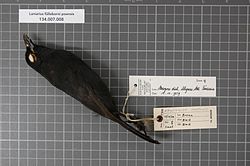| Mountain sooty boubou | |
|---|---|
 | |
| Scientific classification | |
| Kingdom: | Animalia |
| Phylum: | Chordata |
| Class: | Aves |
| Order: | Passeriformes |
| Family: | Malaconotidae |
| Genus: | Laniarius |
| Species: | L. poensis |
| Binomial name | |
| Laniarius poensis (Alexander, 1903) | |
| Subspecies | |
| |
The mountain sooty boubou (Laniarius poensis), western boubou or mountain boubou, is a species of bird in the family Malaconotidae.
